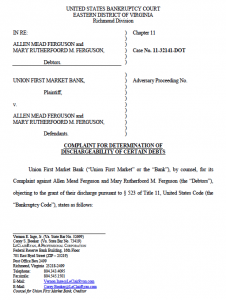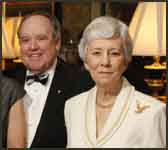A Richmond bank claims it was deceived by a prominent — and now bankrupt — local couple with deep ties to the local business community and charitable scene.
Union First Market Bank is stepping up its fight to get back $800,000 it lent to former Richmond investment banker Allen Mead Ferguson and his wife, Mary Rutherfoord Mercer Ferguson, after the couple allegedly admitted in bankruptcy court that they exaggerated their net worth in attempt to secure a loan.
In a complaint filed Sept. 22, Union claims that at a creditors meeting in May, Allen Ferguson admitted the couple had “falsely represented to numerous banks and possibly other creditors that they owned a $2 million bond portfolio, which they did not own.”
Union has asked federal bankruptcy court to ensure the Fergusons remain on the hook for the debt because it was secured, in part, based on claims of millions of dollars in investment assets that didn’t actually exist.
Specifically to Union’s case, the filing claims Allen Ferguson, who is the former chief executive of old line bond firm Cragie Inc., admitted at the creditors meeting that a $2 million bond account and $1 million in deferred compensation listed in financial statements from the couple “simply did not exist” and that the statements were provided with the intent to deceive the bank.
Allen Ferguson has made similar admissions under oath on other occasions, the filing says.
Union also claims that the Fergusons listed assets that had already been pledged as collateral to another lender.
Other banks are hot on Union’s heels to file similar claims, bankruptcy records show.
The Fergusons filed for Chapter 11 bankruptcy protection in March.
At the time, they were going to work out an orderly plan to repay their debts. But their case was converted to Chapter 7 liquidation in June.
In August 2009, the couple took out an $800,000 promissory note with Union predecessor First Market Bank. It was a note that had renewed from previous years and was originally guaranteed by Mary Ferguson. The latest renewal matured in 2010 and is in default, according to the case.
As they renewed the note over the years, the Fergusons provided signed financial statements to the bank, presumably to show they had the assets of creditworthy borrowers.
Bankruptcy rules state that debt may not be discharged if it was obtained by materially false statements in writing.
Union is not the only bank in town that has sniffed out the alleged deceit. Wells Fargo and EVB have asked the court for an extension to allow them to file complaints based on similar concerns.
Wells Fargo is owed $655,000 by the Fergusons. EVB, the couple’s largest creditor, is owed $1.54 million.
Wells Fargo said it discovered that the Fergusons “significantly overstated their assets in connection with the note.”
The Chapter 7 trustee working the case also filed an extension so he can investigate the banks’ claims. The trustee’s filings say the Fergusons have substantial personal assets, including artwork and other items, that have not been disclosed to the bankruptcy court.
Vernon Inge, an attorney with LeClairRyan who is representing Union in the case, declined to comment.
Roy Terry, an attorney with DurretteCrump who is representing the Fergusons, said he had not seen the case and had no comment.
Bill Cimino, spokesman for Union First Market Bank, said the bank does not comment on pending litigation.
The couple’s business assets, which include local rug companies and real estate that were family businesses owned by Mary Ferguson, were recently put into bankruptcy to prevent creditors from going after them as collateral. EVB and Union First Market Bank are the creditors with claims to the businesses.
Most of those assets are in the process of being sold. A deal for land that the couple owned in Manchester has already closed.
Despite their financial troubles, the Fergusons gave more than $5,000 to various charities in 2010, according to the bankruptcy filings. Recipients included the Society of the Cincinnati, St. Christopher’s School, Valentine Richmond History Center, Colonial Dames and Riverside School.
A Richmond bank claims it was deceived by a prominent — and now bankrupt — local couple with deep ties to the local business community and charitable scene.
Union First Market Bank is stepping up its fight to get back $800,000 it lent to former Richmond investment banker Allen Mead Ferguson and his wife, Mary Rutherfoord Mercer Ferguson, after the couple allegedly admitted in bankruptcy court that they exaggerated their net worth in attempt to secure a loan.
In a complaint filed Sept. 22, Union claims that at a creditors meeting in May, Allen Ferguson admitted the couple had “falsely represented to numerous banks and possibly other creditors that they owned a $2 million bond portfolio, which they did not own.”
Union has asked federal bankruptcy court to ensure the Fergusons remain on the hook for the debt because it was secured, in part, based on claims of millions of dollars in investment assets that didn’t actually exist.
Specifically to Union’s case, the filing claims Allen Ferguson, who is the former chief executive of old line bond firm Cragie Inc., admitted at the creditors meeting that a $2 million bond account and $1 million in deferred compensation listed in financial statements from the couple “simply did not exist” and that the statements were provided with the intent to deceive the bank.
Allen Ferguson has made similar admissions under oath on other occasions, the filing says.
Union also claims that the Fergusons listed assets that had already been pledged as collateral to another lender.
Other banks are hot on Union’s heels to file similar claims, bankruptcy records show.
The Fergusons filed for Chapter 11 bankruptcy protection in March.
At the time, they were going to work out an orderly plan to repay their debts. But their case was converted to Chapter 7 liquidation in June.
In August 2009, the couple took out an $800,000 promissory note with Union predecessor First Market Bank. It was a note that had renewed from previous years and was originally guaranteed by Mary Ferguson. The latest renewal matured in 2010 and is in default, according to the case.
As they renewed the note over the years, the Fergusons provided signed financial statements to the bank, presumably to show they had the assets of creditworthy borrowers.
Bankruptcy rules state that debt may not be discharged if it was obtained by materially false statements in writing.
Union is not the only bank in town that has sniffed out the alleged deceit. Wells Fargo and EVB have asked the court for an extension to allow them to file complaints based on similar concerns.
Wells Fargo is owed $655,000 by the Fergusons. EVB, the couple’s largest creditor, is owed $1.54 million.
Wells Fargo said it discovered that the Fergusons “significantly overstated their assets in connection with the note.”
The Chapter 7 trustee working the case also filed an extension so he can investigate the banks’ claims. The trustee’s filings say the Fergusons have substantial personal assets, including artwork and other items, that have not been disclosed to the bankruptcy court.
Vernon Inge, an attorney with LeClairRyan who is representing Union in the case, declined to comment.
Roy Terry, an attorney with DurretteCrump who is representing the Fergusons, said he had not seen the case and had no comment.
Bill Cimino, spokesman for Union First Market Bank, said the bank does not comment on pending litigation.
The couple’s business assets, which include local rug companies and real estate that were family businesses owned by Mary Ferguson, were recently put into bankruptcy to prevent creditors from going after them as collateral. EVB and Union First Market Bank are the creditors with claims to the businesses.
Most of those assets are in the process of being sold. A deal for land that the couple owned in Manchester has already closed.
Despite their financial troubles, the Fergusons gave more than $5,000 to various charities in 2010, according to the bankruptcy filings. Recipients included the Society of the Cincinnati, St. Christopher’s School, Valentine Richmond History Center, Colonial Dames and Riverside School.





So….it’s not just a case of living beyond their means? Now it looks like FRAUD….which is a CRIME.
Coming from a partial background in banking/finance, I can only ask – why did these financial institutions not verify the legitimacy and status of these “assets” prior to giving loans?
Daniel, if you have a signed financial statement from a borrower, they agree to the disclaimer that it is ‘true and accurate’. If it’s not, it’s fraud. That’s why the banks didn’t verify the assets, the borrower attested it was there.
Smoke and mirrors, the same way French got his money.
OK, let me get this straight: these very nice folks said that they had a $2MM bond portfolio in order to secure a line of credit, and they … didn’t? Who’s running UFMB? How on earth is a simple attestation by a borrower sufficient at that level? Or any other level, for that matter. There are a host of questions here, starting with how a good reputation in a small city can get you access, and money, based on your word alone. Is the bank officer who OK-ed this deal still employed by UFMB? I bank there, and that’s a… Read more »
I’m so glad the truth is coming out about the Fergusons and their crimes. The first stories were so sympathetic as if they were victims of a cruel stock market. Now we see the truth.
Im worried because I work for one of the companies “owned” by the Ferguson’s……I need new employment NOW! If anyone has any lead, let me know!